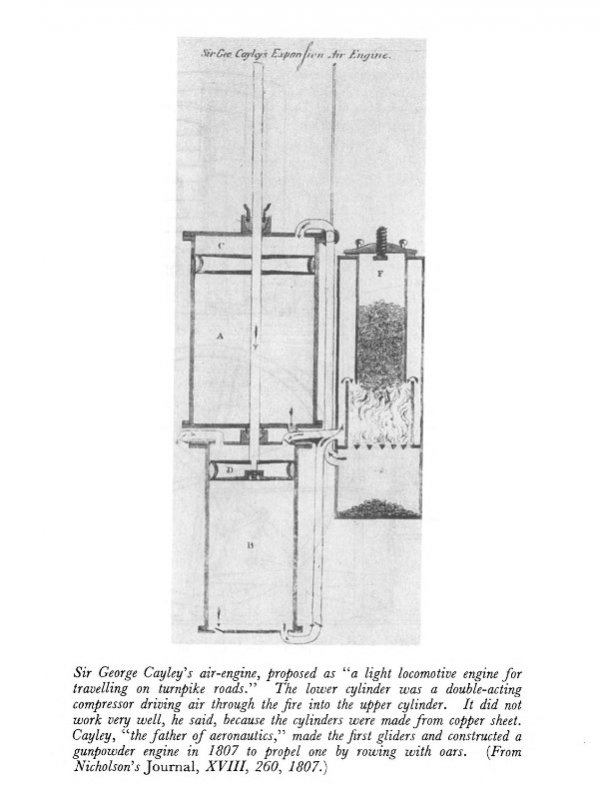Engine for affording mechanical power from air expanded by heat
Source: The Emporium for Arts and Sciences, Vol II, n°1, p 376 - Publishing a letter of Cayley written to the Nicholson's Journal.
Date: December, 1813
Title: Letter to M. Nicholson
Authors: John Redman Coxe, Thomas Cooper
Description of an Engine for affording mechanical power from air expanded by heat; by Sir George Cayley.
To Mr. NICHOLSON.
Brompton, Sept. 25, 1807.
Sir,
I OBSERVED in your last vol. p. 368, that some experiments have been lately made in France upon air, expanded by heat, applied as a first mover for mechanical purposes. This idea, as you justly remark, is by no means new in this country; yet I have not heard that any successful experiments have been made, exclusively upon this principle, in England, though you hint that some thing promising has been accomplished relative to it.
The subject is of much importance, as the steam engine has hitherto proved too weighty and cumbrous for most purposes of locomotion; whereas the expansion of air seems calculated to supply a mover free from these defects.
Under this impression I send you a sketch of an engine I projected upon this principle several years ago; it was made on a considerable scale at Newcastle, though I must confess without success in the result, which I attributed to the imperfect manner in which it was executed, the cylinders being made of sheet copper, and so irregular, as not to be rendered tolerably air tight by any packing of the piston, I think there can be no doubt that the scheme is practicable in some way or other; and I conceive that the form of the engine here sketched will be the basis of whatever experience may prove to be additional requisite to perfection in the apparatus of the air engine.

A and B, Plate 8 fig. 1, are two cylinders, placed one above another; C and D, their respective pistons connected by one rod. F is a cylinder, containing a fire in a vessel within it in such a manner, that any air passing between the upper and lower portions of it must go through the fire. This vessel also contains a long cylinder, open at the bottom and directly over the centre of the fire, for the purpose of holding coke or other fuel.
This cylinder is covered at the top, and packed air tight when it has served the purpose of permitting the fire to be kindled through it: and has been filled with fuel.
The cylinder B is fitted up to answer the purpose of a double stroke forcing pump, or bellows, to drive the air into the upper portion of the vessel F, from whence it passes downwards through the fire for the purpose of consuming the smoke (the fresh fuel being supplied from the reservoir above) in its passage through the more completely ignited cinders below. In this act the air is expanded; and, by means of pipes from the lower portion of F, it is conveyed alternately above and below the piston of the cylinder A. In each pipe is fixed a stop cock or valve, so constructed as to open a passage to the external air, when it shuts the connection with the fire vessel.
These cocks are worked by a plug frame.
From this construction it will appear evident, that whatever expansion the air receives, its pressure will operate alike upon the piston of the bellows and of the receiver; and that always in opposition to each other: Hence the power of the stroke will be in proportion to the excess of the area of the receiving piston, over that of the feeding one, multiplied by the expansive force of the contained air, and by the length of the movement.
If, when the engine is well constructed, the expansion of the air in keeping up the firebe not found sufficiently sensible, still the form of the engine is such as to admit of either inflammable gas, oil of tar, or other inflammable matters, being injected, each stroke, upon the fire; so that all the heat generated by the united combustion may operate without waste; perhaps even a slight sprinkling of water, either upon, or round the sides of the fire, might answer the purpose. It scarcely need be observed, that a tube connected with a small forcing pump are the only things required for producing these effects.
I remain, Sir,
Your obedient servant,
GEORGE CAYLEY.